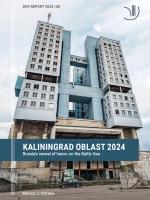Kaliningrad Oblast 2024
Kaliningrad Oblast, created as a symbol of Soviet victory in the Second World War, has always been under Moscow’s watchful eye. It grew to become a showcase of Russia’s new foreign and domestic policies after Vladimir Putin came back to the presidential seat in 2012. As a consequence, its dependency from the federal centre has reached unprecedently high levels. Separated from mainland Russia by EU and NATO countries, the Oblast has sharply experienced political, economic, and social consequences of this belligerent approach.
Today, over two years after the full-scale invasion of Ukraine, Russian authorities claim Kaliningrad Oblast is at the forefront of Russia’s defensive war against the West. It is a bulwark of Kremlin-defined Russianness with its traditional values and militarisation of history. Regional politicians, rather than advocating for the Oblast’s interests, use it as a trampoline to Moscow. Regional economy is being overtaken by federal-level oligarchs and security services.
These dynamics influence the EU-Russia and NATO-Russia relations and have a direct impact on Denmark’s security. Kaliningrad Oblast is likely to play an even more active role in Russia’s havoc-wreaking actions in the Baltic Sea Region, such as targeting critical energy and telecommunications infrastructure, aerial and maritime provocations, and playing with the threat posed by seabed explosives, particularly in the vicinity of Bornholm.


